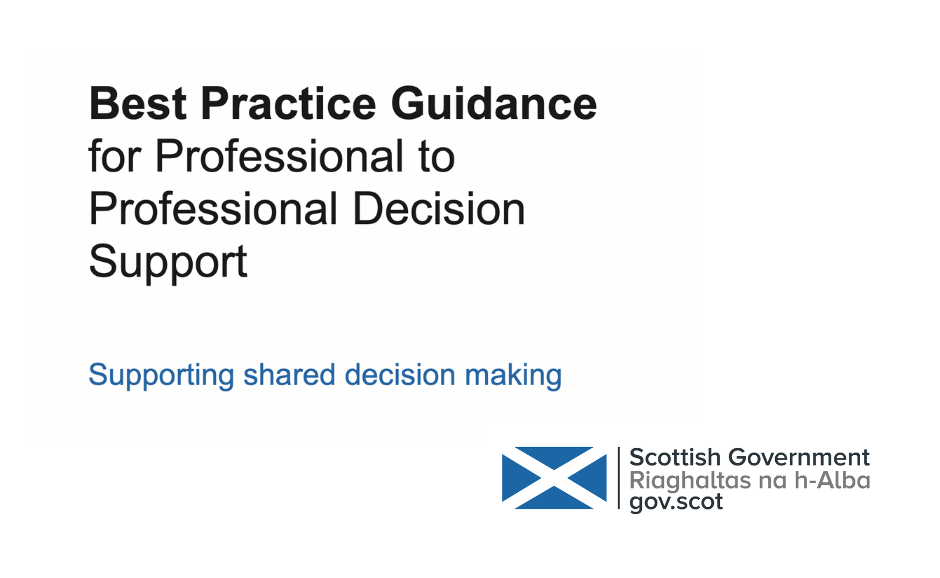We’re delighted that Consultant Connect is featured in the Scottish Government Best Practice Document: Best Practice Guidance for Professional to Professional Decision Support. We’ve replicated the features below, or you can click here to read the guidance in full.
Appendix C – Local Framework Example
NHS Tayside professional to professional services support an innovative multi-front door model which enables direct access to services such as Acute Medicine, COVID Assessment, Cardiology and Stroke; supporting delivery of providing early definitive care for patients and supporting the aim of care from the right person, in the right place, first time. This also allows their Emergency Departments to provide timely patient care, which is reflected in sustained performance against unscheduled care targets, and no identified issues with ambulance “stacking”.
Their existing framework means that it was possible to rapidly establish a dedicated professional to professional advice line for the COVID Assessment Unit, which was launched on the 13th March 2020. This dedicated unit directly accepts patients with known or suspected COVID-19 and provides rapid assessment, alternatives to admission or admission to the specialist ‘hospital within a hospital’. This ensures that the ‘assess to admit’ principle successfully applied in other unscheduled care areas is equally embedded in the Tayside COVID model.
Since September 2018, professional to professional services have been supported by Consultant Connect enabling call recording and effective activity analysis. Over 50,000 calls have been handled through the system in Tayside.
Professional to professional advice is available to Primary Care in and Out of Hours, Scottish Ambulance Service, NHS 24 and regional services such as Minor Injury Units and prison health services via a dedicated telephone line. This ensures senior clinical decision maker advice early in the patient journey.
Data analysis of these services over the last 10 years consistently shows the efficacy of this approach. Even more so since the introduction of the COVID Assessment Unit in March 2020 and the establishment of a local Flow Navigation Centre as part of the RUC programme in December 2020 including:
- Consistent 30% alternative to hospital attendance in calls from the Scottish Ambulance Service
- 30% reduction in acute inter-hospital transfers
- 35-40% of NHS 24 Direct Referrals to Flow Navigation Centre result in “non-ED attendance”
- Only 20% of patients receiving a 4-hour call back from the Flow Navigation Centre require an unscheduled attendance at the Emergency Department
- During “wave 2” 30% of patients discussed with the COVID Assessment Unit did not attend hospital
Through promoting availability of professional to professional services, uptake and use of the service has significantly increased during the COVID pandemic. During this time outcomes of calls including accessing care outside the hospital environment in 30% of cases were maintained, significantly increasing the number of patients accessing early community care and avoiding unnecessary hospital attendance. These pre-hospital remote consultations have also resulted in a significant decrease in inter hospital transfer between their two acute sites.
Appendix D – Patient Case Study Examples
Example 1: NHS Greater Glasgow and Clyde (Primary Care)
Patient: Female / Aged 55 years
History: Patient had experienced 6 weeks of persistent vomiting and feeling unwell. Patient taking methotrexate for Rheumatoid Arthritis. Recurrent contacts with GP (phone and face to face). Bloods had persistently shown raised white cells and lymphocytosis, low albumin and raised Alkaline Phosphatase
Situation: Deterioration in condition and consideration of admission
Response: Use of Consultant Connect to link with the Acute Consultant on call. Discussion held regarding case and agreement made to see the patient the following day to have imaging undertaken
Results: Patient diagnosed with Crohns disease with hospital admission avoided by prioritising the Professional to Professional discussion and also having the facility to see the patient (“hot clinic”) the next day, alongside easy access to CT scan
Example 2: NHS Lanarkshire (Cardiology)
Patient: Female / Aged 62 years
History: Patient presented to their GP with intermittent palpitations in the context of known Atrial Fibrillation. This had been occurring for a long period of time despite various attempts to reduce symptoms with different medications
Situation: Patient was becoming increasingly frustrated about the symptoms and was starting to develop associated symptoms of shortness of breath when exerting herself
Response: The patient’s GP would have previously considered an unscheduled care referral to an acute site due to tachycardia and failed attempts to control with medications. However GP utilised Consultant Connect to obtain professional to professional advice from a Consultant Cardiologist at University Hospital Hairmyres
Results: The Consultant Cardiologist was able to look at previous telemetry, out-patient echocardiogram images and recent community blood results, providing advice with regards to change in medications. Both decided that the patient would be suitable for catheter ablation and the patient was added to the ablation waiting list at the point of discussion
